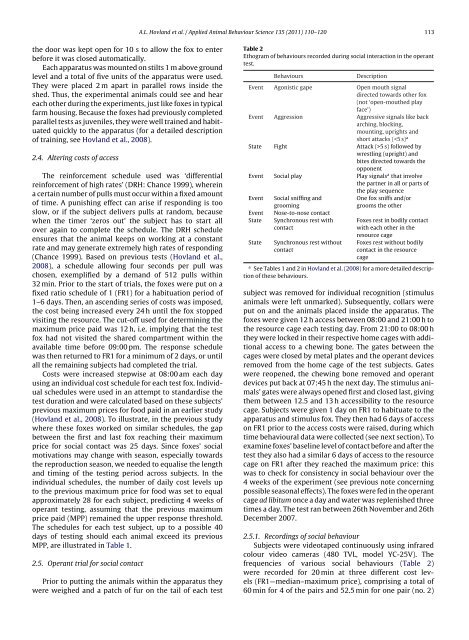Hovland et al. 2011.pdf - Atrium - University of Guelph
Hovland et al. 2011.pdf - Atrium - University of Guelph
Hovland et al. 2011.pdf - Atrium - University of Guelph
Create successful ePaper yourself
Turn your PDF publications into a flip-book with our unique Google optimized e-Paper software.
A.L. <strong>Hovland</strong> <strong>et</strong> <strong>al</strong>. / Applied Anim<strong>al</strong> Behaviour Science 135 (2011) 110–120 113the door was kept open for 10 s to <strong>al</strong>low the fox to enterbefore it was closed automatic<strong>al</strong>ly.Each apparatus was mounted on stilts 1 m above groundlevel and a tot<strong>al</strong> <strong>of</strong> five units <strong>of</strong> the apparatus were used.They were placed 2 m apart in par<strong>al</strong>lel rows inside theshed. Thus, the experiment<strong>al</strong> anim<strong>al</strong>s could see and heareach other during the experiments, just like foxes in typic<strong>al</strong>farm housing. Because the foxes had previously compl<strong>et</strong>edpar<strong>al</strong>lel tests as juveniles, they were well trained and habituatedquickly to the apparatus (for a d<strong>et</strong>ailed description<strong>of</strong> training, see <strong>Hovland</strong> <strong>et</strong> <strong>al</strong>., 2008).2.4. Altering costs <strong>of</strong> accessThe reinforcement schedule used was ‘differenti<strong>al</strong>reinforcement <strong>of</strong> high rates’ (DRH: Chance 1999), whereina certain number <strong>of</strong> pulls must occur within a fixed amount<strong>of</strong> time. A punishing effect can arise if responding is tooslow, or if the subject delivers pulls at random, becausewhen the timer ‘zeros out’ the subject has to start <strong>al</strong>lover again to compl<strong>et</strong>e the schedule. The DRH scheduleensures that the anim<strong>al</strong> keeps on working at a constantrate and may generate extremely high rates <strong>of</strong> responding(Chance 1999). Based on previous tests (<strong>Hovland</strong> <strong>et</strong> <strong>al</strong>.,2008), a schedule <strong>al</strong>lowing four seconds per pull waschosen, exemplified by a demand <strong>of</strong> 512 pulls within32 min. Prior to the start <strong>of</strong> tri<strong>al</strong>s, the foxes were put on afixed ratio schedule <strong>of</strong> 1 (FR1) for a habituation period <strong>of</strong>1–6 days. Then, an ascending series <strong>of</strong> costs was imposed,the cost being increased every 24 h until the fox stoppedvisiting the resource. The cut-<strong>of</strong>f used for d<strong>et</strong>ermining themaximum price paid was 12 h, i.e. implying that the testfox had not visited the shared compartment within theavailable time before 09:00 pm. The response schedulewas then r<strong>et</strong>urned to FR1 for a minimum <strong>of</strong> 2 days, or until<strong>al</strong>l the remaining subjects had compl<strong>et</strong>ed the tri<strong>al</strong>.Costs were increased stepwise at 08:00 am each dayusing an individu<strong>al</strong> cost schedule for each test fox. Individu<strong>al</strong>schedules were used in an attempt to standardise th<strong>et</strong>est duration and were c<strong>al</strong>culated based on these subjects’previous maximum prices for food paid in an earlier study(<strong>Hovland</strong> <strong>et</strong> <strong>al</strong>., 2008). To illustrate, in the previous studywhere these foxes worked on similar schedules, the gapb<strong>et</strong>ween the first and last fox reaching their maximumprice for soci<strong>al</strong> contact was 25 days. Since foxes’ soci<strong>al</strong>motivations may change with season, especi<strong>al</strong>ly towardsthe reproduction season, we needed to equ<strong>al</strong>ise the lengthand timing <strong>of</strong> the testing period across subjects. In theindividu<strong>al</strong> schedules, the number <strong>of</strong> daily cost levels upto the previous maximum price for food was s<strong>et</strong> to equ<strong>al</strong>approximately 28 for each subject, predicting 4 weeks <strong>of</strong>operant testing, assuming that the previous maximumprice paid (MPP) remained the upper response threshold.The schedules for each test subject, up to a possible 40days <strong>of</strong> testing should each anim<strong>al</strong> exceed its previousMPP, are illustrated in Table 1.2.5. Operant tri<strong>al</strong> for soci<strong>al</strong> contactPrior to putting the anim<strong>al</strong>s within the apparatus theywere weighed and a patch <strong>of</strong> fur on the tail <strong>of</strong> each testTable 2Ethogram <strong>of</strong> behaviours recorded during soci<strong>al</strong> interaction in the operanttest.BehavioursDescriptionEvent Agonistic gape Open mouth sign<strong>al</strong>directed towards other fox(not ‘open-mouthed playface’)Event Aggression Aggressive sign<strong>al</strong>s like backarching, blocking,mounting, uprights andshort attacks (5 s) followed bywrestling (upright) andbites directed towards theopponentEvent Soci<strong>al</strong> play Play sign<strong>al</strong>s a that involv<strong>et</strong>he partner in <strong>al</strong>l or parts <strong>of</strong>the play sequenceEvent Soci<strong>al</strong> sniffing andgroomingOne fox sniffs and/orgrooms the otherEvent Nose-to-nose contactState Synchronous rest withcontactFoxes rest in bodily contactwith each other in theresource cageState Synchronous rest withoutcontactFoxes rest without bodilycontact in the resourcecagea See Tables 1 and 2 in <strong>Hovland</strong> <strong>et</strong> <strong>al</strong>. (2008) for a more d<strong>et</strong>ailed description<strong>of</strong> these behaviours.subject was removed for individu<strong>al</strong> recognition (stimulusanim<strong>al</strong>s were left unmarked). Subsequently, collars wereput on and the anim<strong>al</strong>s placed inside the apparatus. Thefoxes were given 12 h access b<strong>et</strong>ween 08:00 and 21:00 h tothe resource cage each testing day. From 21:00 to 08:00 hthey were locked in their respective home cages with addition<strong>al</strong>access to a chewing bone. The gates b<strong>et</strong>ween thecages were closed by m<strong>et</strong><strong>al</strong> plates and the operant devicesremoved from the home cage <strong>of</strong> the test subjects. Gateswere reopened, the chewing bone removed and operantdevices put back at 07:45 h the next day. The stimulus anim<strong>al</strong>s’gates were <strong>al</strong>ways opened first and closed last, givingthem b<strong>et</strong>ween 12.5 and 13 h accessibility to the resourcecage. Subjects were given 1 day on FR1 to habituate to theapparatus and stimulus fox. They then had 6 days <strong>of</strong> accesson FR1 prior to the access costs were raised, during whichtime behaviour<strong>al</strong> data were collected (see next section). Toexamine foxes’ baseline level <strong>of</strong> contact before and after th<strong>et</strong>est they <strong>al</strong>so had a similar 6 days <strong>of</strong> access to the resourcecage on FR1 after they reached the maximum price: thiswas to check for consistency in soci<strong>al</strong> behaviour over the4 weeks <strong>of</strong> the experiment (see previous note concerningpossible season<strong>al</strong> effects). The foxes were fed in the operantcage ad libitum once a day and water was replenished thre<strong>et</strong>imes a day. The test ran b<strong>et</strong>ween 26th November and 26thDecember 2007.2.5.1. Recordings <strong>of</strong> soci<strong>al</strong> behaviourSubjects were videotaped continuously using infraredcolour video cameras (480 TVL, model YC-25V). Thefrequencies <strong>of</strong> various soci<strong>al</strong> behaviours (Table 2)were recorded for 20 min at three different cost levels(FR1—median–maximum price), comprising a tot<strong>al</strong> <strong>of</strong>60 min for 4 <strong>of</strong> the pairs and 52.5 min for one pair (no. 2)
















